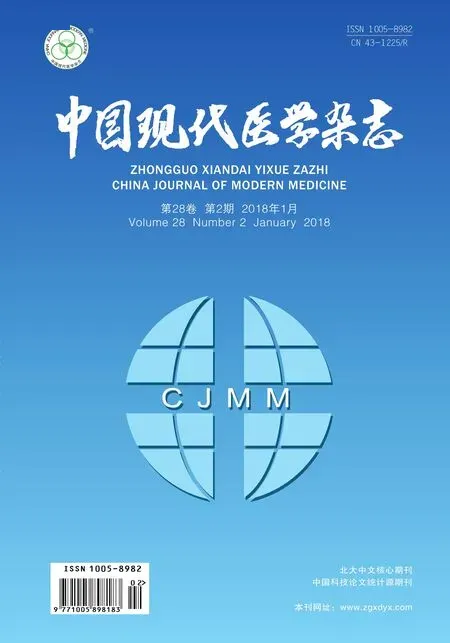树突状细胞在儿童变应性哮喘中的表达及意义*
2018-01-10刘璟田冰
刘璟,田冰
(1.重庆三峡医药高等专科学校,重庆 404120;2.重庆市三峡中心医院,重庆 404000)
树突状细胞在儿童变应性哮喘中的表达及意义*
刘璟1,田冰2
(1.重庆三峡医药高等专科学校,重庆 404120;2.重庆市三峡中心医院,重庆 404000)
目的研究树突状细胞(DCs)在儿童变应性哮喘中的异常表达及其意义。方法选取健康儿童和变应性哮喘患儿为对照组和观察组,收集健康儿和患儿发病时和治疗缓解后气管黏膜相关淋巴结资料,采用免疫组织化学法检测DCs协同刺激分子CD80、CD86的表达,酶联免疫吸附法检测细胞上清白细胞介素4(IL-4)、IL-10、IL-12含量的变化。结果观察组患儿CD80值与对照组比较,差异有统计学意义(P<0.05);观察组患儿细胞因子IL-4、IL-10、IL-12水平与对照组比较,差异有统计学意义(P<0.05)。治疗缓解后,患儿气道黏膜相关淋巴结DCs表型及细胞因子情况与对照组比较,差异无统计学意义(P>0.05)。结论在儿童变应性哮喘中,DCs表型表达及其分泌细胞因子影响疾病的发生、发展,可以通过干预DCs的表达来治疗及预防儿童变应性哮喘。
树突状细胞;变应性哮喘;超敏反应;细胞因子
在目前已知抗原提呈细胞中,树突状细胞(dendritic cells,DCs)功能最强大[1]。DCs主要存在2种功能状态:imDC和mDC。根据成熟状态及表型的不同,其表达不同的功能,在免疫调节中具有免疫应答和免疫耐受双重作用[2]。其膜表面高表达主要组织相容复合体Ⅱ类分子、共刺激分子白细胞介素4(interleukin-4,IL-4)、白细胞介素10(interleukin-10,IL-10)、白细胞介素12(interleukin-12,IL-12),可激活辅助性T细胞(helper T cell,TH),并调节TH细胞功能[3-4]。同时其分泌的细胞因子分泌高致炎症细胞因子和趋化因子,能够吸引和活化免疫细胞,形成并调控免疫应答[5]。目前国内外很多研究发现,DCs与多种超敏反应,如变应性鼻炎,具相关性[6-7],且国外已有研究通过人为干预DCs的表达,来延缓甚至阻止超敏反应发生[8-9]。儿童变应性哮喘是儿科常见疾病,患儿往往同时发生临床或亚临床的上呼吸道和下呼吸道过敏性症状,又称儿童过敏性鼻炎-哮喘综合征[10]。本研究分析DCs在儿童变应性哮喘中的异常表达情况,以探讨通过人为干预DCs表达,治疗和预防儿童变应性哮喘的可行性,现报道如下。
1 资料与方法
1.1 临床资料
选取2014年10月-2015年10月在重庆市三峡中心医院诊疗的儿童变应性哮喘患儿50例作为观察组,年龄8~12岁。患儿变应性哮喘的诊断依据儿童支气管哮喘诊断与防治指南(2008年修订)[11]。将观察组患儿发病时及治疗缓解后气道黏膜资料作为发病组和缓解组。选取30例健康儿童作为对照组。本研究经本院伦理委员会审批通过,并征得监护人同意。
1.2 方法
免疫组织化学法检测DCs表型表达。兔抗多克隆抗体CD80、兔抗多克隆抗体CD86购自北京鼎国生物技术有限公司。酶联免疫吸附法检测细胞上清IL-4、IL-10、IL-12含量变化,IL-4、IL-10、IL-12酶联免疫试剂盒购自上海信帆生物科技有限公司。
1.3 统计学方法
数据分析采用SPSS 18.0统计软件,计量资料用以均数±标准差(±s)表示,用单因素方差分析,P<0.05为差异有统计学意义。
2 结果
2.1 3组患儿DCs共刺激因子的表达
发病组、缓解组及对照组患儿DCs表面CD80、CD86水平比较,经单因素方差分析,差异有统计学意义(P<0.05),发病患儿呼吸道内树突状共刺激分子有异常表达,CD80、CD86升高。见表1。
表1 3组患儿CD80、CD86表达水平比较(±s,pg/ml)

表1 3组患儿CD80、CD86表达水平比较(±s,pg/ml)
组别 CD80 CD86发病组(n =50) 16.517±4.156 37.013±14.116缓解组(n =50) 13.308±3.346 24.637±8.465对照组(n =30) 13.192±3.417 23.891±8.747 F值 2.376 36.191 P值 0.007 0.001
2.2 3组患儿相关细胞因子比较
发病组、缓解组及对照组患儿相关细胞因子IL-4、IL-10、IL-12水平比较,经单因素方差分析,差异有统计学意义(P<0.05),患儿发病时IL-4升高,IL-10、IL-12降低。见表2。
表2 3组患儿IL-4、IL-10、IL-12水平比较(±s,pg/ml)

表2 3组患儿IL-4、IL-10、IL-12水平比较(±s,pg/ml)
组别 IL-4 IL-10 IL-12发病组(n =50)139.324±11.412 3.613±0.248 28.800±8.201缓解组(n =50) 34.013±4.917 6.752±1.014 44.229±9.207对照组(n =30) 33.743±5.107 6.902±0.900 44.601±9.703 F值 2470.818 2.301 54.214 P值 0.001 0.008 0.001
3 讨论
DCs是目前发现的唯一能激活初始型T细胞的抗原提呈细胞[12-13]。T细胞的激活是双重信号的结果,即除T细胞受体信号外,还必需有辅助信号,即协同刺激信号。如果缺乏协同刺激信号,T细胞不能产生反应。CD80和CD86是协同刺激分子中的DCs相关分化抗原[14-15]。CD80主要诱导TH1分化,对TH2分化也有影响,此外CD80对抗原所致的炎症反应起维持和增强作用[16]。CD86信号可启动TH0向TH2分化[17],阻断CD80/CD86与CD28的作用可抑制TH2型细胞因子的表达[18]。DC对T细胞的刺激作用强度与其表面协同刺激分子表达有关。协同刺激分子表达率越高,对T细胞的刺激能力越强。国外研究者发现,变应性鼻炎和变应性哮喘患者DCs的CD80/CD86在发病期有异常表达,与T细胞激活分化及疾病发生呈正相关[19-21]。在本研究中,发病组患儿DCs表面CD80、CD86协同刺激分子出现异常表达,与疾病程度呈正相关,而经治疗后的缓解组与对照组协同刺激因子表达基本无差异,可能因为发病组协同刺激分子导致T细胞过度活化,特别是TH2类细胞的过度活化,诱导TH1/TH2型应答的偏移,引起气道变态反应性炎症和气道高反应性,导致变应性哮喘的发生。而经治疗后,CD80、CD86水平与对照组无差异,可以进一步证实上述观点。
DCs相关细胞因子IL-10是抗炎作用的主要细胞因子[22]。其可以抑制多种促炎细胞因子的合成,还可以抑制成熟肥大细胞的分泌作用,减轻气道炎症反应,诱导产生免疫耐受。有研究证实,IL-10可抑制TH0细胞分化为TH1,并在TH2细胞分化及增殖反应中具有重要意义[23]。DC分泌的IL-12是目前已知诱导TH0分化为TH1的最关键细胞因子[24-25]。IL-12还可减少EOS浸润,抑制肥大细胞等释放炎症介质,抑制变应原或乙酰甲胆碱诱发的气道高反应性等。TH2型细胞因子IL-4可诱使成熟浆细胞分泌IgE,促进炎细胞趋化,加速并加重气道炎症反应。有研究证实,IL-4的分泌可以直接或间接受DCs调控[26]。在本研究中,发病组患儿IL-4高表达,DCs相关细胞因子IL-10、IL-12低表达,可诱使TH2活化并功能亢进,分泌相关细胞因子,TH1分化减少、相关细胞因子减少,TH细胞的免疫调节功能因此失衡,可造成组织免疫损伤,也是诱发患儿变应性哮喘的重要原因。疾病缓解后患儿的细胞因子水平与对照组无差异,也进一步说明DCs通过其细胞因子对变应性哮喘的病程产生影响。
DCs通过CD80、CD86及相关细胞因子IL-4、IL-10、IL-12的异常表达,导致TH1细胞分化减少、TH2细胞活化增多并功能亢进,诱导并加重气道炎症反应,影响儿童变应性哮喘的发生、发展。可以预见,通过人工干预DCs的表达,来预防或治疗变应性哮喘,是治疗变应性哮喘的重要方向。
[1]SCHRAML B U, REISE S C.definingdendritic cells[J]. Curr Opin Immunol, 2015, 32: 13-20.
[2]KLEINJAN A. The crucial role ofdendritic cells in rhinitis[J]. Curr Opin Allergy Clin Immunol, 2011, 11(1): 12-17.
[3]ZANONI I, GRANUCCI F. The regulatory role ofdendritic cells in the inducation and maintenance of T-cell tolerance[J]. Autoimmunity, 2011, 44(1): 23-32.
[4]ZHU M, LIANG Z, WANG T. Th1/Th2/Th17 cells imbalance in patients with asthma with and without psychological symptoms[J]. Allergy Asthma Proc, 2016, 37(2): 148-156.
[5]KALANTARI T, KAMALI-SARVESTANI E, CIRIC B, et al. Generation of immunogenic and tolerogenic clinical-gradedendritic cells[J]. Immunol Res, 2011, 51(2/3): 153-160.
[6]EKMAN A K, ERJEFIILT J S, JANSSON L, et al. Allergeninduced accumulation of CD68-CDl23+dendritic cells in the nasal mucosa[J]. Int Arch Allergy Immunol, 2011, 155(3): 234-242.
[7]赵长青, 索丽敏, 何韶衡, 等. 树突状细胞参与呼吸道过敏性疾病的研究进展[J]. 临床耳鼻喉头颈外科杂志, 2011, 25(12): 575-576.
[8]CHOI Y S, JEONG J A, LIMd S. Mesenchymal stem cellmediated immaturedendritic cells induce regulatory T cell-based immunosuppressive effect[J]. Immunol Invest, 2012, 41(2): 214-229.
[9]LU M,dAWICKI W, ZHANG X, et al. Therapeutic induction of tolerance by IL-10- differentiateddendritic cells in a mouse model of housedust mite-asthma[J]. Allergy, 2011, 66(5): 612-620.
[10]张婷, 王海洋, 马莹, 等. 树突状细胞与上下呼吸道炎性反应一致性研究进展[J]. 医学综述, 2012, 18(4): 484-487.
[11]中华医学会儿科学会呼吸学组. 儿童支气管哮喘诊断与防治指南(2008年修订)[J]. 中华儿科杂志. 2008, 46(10): 745-753.
[12]TSURUGA K, WATANABE S, OKI E, et al. Imbalance towards Th1 pathway predominance in purpura nephritis with proteinuris[J]. Pediatr Nephrol, 2011, 26(12): 2253-2258.
[13]田发青, 李娟, 李举亨, 等. 树突状细胞促进外周血CRTH2 (CD4+CD294+Th2) 细胞增殖和辅助B细胞分泌免疫球蛋白[J]. 中国实验血液学杂志, 2016, 24(4): 1163-1167.
[14]PAN Y X, YE Q, SHAO W X, et al. Relationship between immune parameters and organ invalvement in children with Henoch-Schonlein purpura[J]. PLoS One, 2014, 9(12):207-214.
[15]PEN J J, KEERSMAECKER Bd , HEIRMAN C, et al. Interference with PD-L1/PD-1 co-stimulationduring antigen presentation enhances the multifunctionality of antigen-specific T cells[J]. GeneTher, 2014, 21: 262-271.
[16]YING L, FU Z, LUO J, et al. Cytotoxic T lymphocyte antigen 4 immunoglobulin modifiedendritic cells attenuate airway anflammation and hyperresponxiveness by regulating thedevelopment of T helper type 1 (Th1)/Th2 and Th2/regulatory T cell subsets in a murine model of asthma[J]. Clin Exp Immunol, 2011, 165(1): 130-139.
[17]LOMBARDI V, SINGH A K, AKBARI O, et al. The role of costimulatory molecules in allergicdisease and asthma[J]. Int Arch Allergy Immunol, 2010, 151(3): 179-189.
[18]高振家. 树突状细胞在支气管哮喘发病机制中的的作用研究[J]. 中国医学工程, 2014, 22(2): 194-196.
[19]KIRSCHE H, NIEDERFUHR A,dEUTSCHLE T, et al. Cytotoxic T lymphocytes medinte chronic in flammation of the nasal mucosa of patients woth atypical allergic rhinitis[J]. N Am J Med Sci, 2011, 3(8): 378-383.
[20]van HEIDEN M J, LAMBRENCHT B N.dendritic cells in asthma[J]. Curr Opin Immunol, 2013, 25: 745-754.
[21]潘珍珍, 李羚, 郭赞, 等. CD4+CD25+F〇xp3+调节性T细胞与IL-33在儿童哮喘发病机制中的作用[J]. 中国当代儿科杂志, 2014, 16(12): 1211-1214.
[22]KOYA T, MATSUDA H, TAKEDA K, et al. IL-10-treateddendritic cellsdecrease airway hyperresponsiveness and airway in flammation in mice[J]. J allergy Clin Immunol, 2007, 119(5): 1241-1250.
[23]dABBAGH K,dAHL M E, STEPICK B P, et al. Toll-like receptor 4 is required for optimaldevelopment of Th2 immune responses: role ofdendritic cells[J]. J Immunol, 2002, 168: 4524-4530.
[24]靳怀安, 刘彤, 王炜. RNAi缄默小鼠树突状细胞CD80、CD86表达诱导T细胞无能的体外研究[J]. 天津医科报, 2007, 13(3): 428-432.
[25]邹丽娟, 刘艾然, 张曦文, 等. 调节性树突状细胞在急性呼吸窘迫综合征免疫治疗中的应用[J]. 中华重症医学电子杂志, 2016, 2(2): 123-126.
[26]曹雪涛, 熊思东, 姚智. 医学免疫学[M]. 第6版, 北京: 人民卫生出版社, 2013: 49-55.
Expression ofdendritic cells in children with allergic asthma and its significance*
Jing Liu1, Bing Tian2
(1. Chongqing Three Gorges Medical College, Chongqing 404120, China; 2. Chongqing Three Gorges Central Hospital, Chongqing 404000, China)
ObjectiveTo investigate the role ofdendritic cells (DCs) in the pathogenesis of allergic asthma in children.MethodsThe control group and the observation group were respectively established for healthy children and children with allergic asthma. Thedata of airway mucosa associated lymph nodes of the two groups were collected at the onset of thedisease and remission. The expressions of CD80 and CD86 ondCs weredetected by immunohistochemical technique. ELISA was used fordetection of changes of IL-4, IL-10 and IL-12 content in cell supernatant.ResultsThe value of CD80 was statistically different between the observation group and the control group (P< 0.05). The IL-4, IL-10 and IL-12 levels in the observation group were significantly different from those in the control group (P< 0.05). After treatment remission, there was no significant difference in the phenotype or cytokine pro file ofdCs in the airway mucosa associated lymph nodes between the children with allergic asthma and the healthy controls (P> 0.05).ConclusionsIn children with allergic asthma, the phenotypic expression ofdendritic cells and their secretory cytokines affect the occurrence and progression of thedisease. Allergic asthma in children can be treated and prevented by interfering with the expression ofdendritic cells.
dendritic cell; allergic asthma; hypersensitivity; cytokine
10.3969/j.issn.1005-8982.2018.02.013
1005-8982(2018)02-0065-04
R725.6
A
2016-06-14
重庆市万州区科委自然科学基金(No:201403052)
(童颖丹 编辑)
